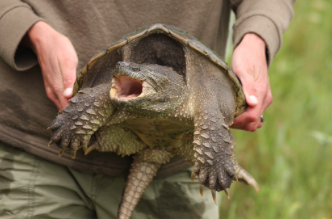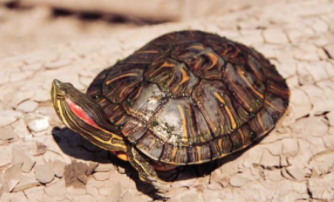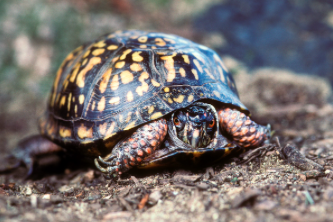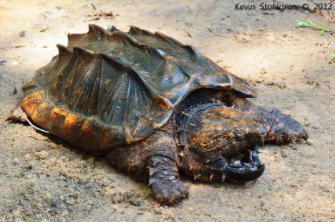All about turtles!
June 22, 2022
by Lindsay Flannery
Do you or your kids love turtles? Or maybe you don’t know much about them and would like to learn more? Either way, you won’t want to miss Kidzeum’s first major traveling exhibit since 2019: Turtle Travels!

Turtle Travels provide an insider’s view into the life of a turtle, which is much more challenging than you might expect. The exhibit coincides with expanded summer hours that began June 13, 2022, when the museum will be open 9-4 every day through August 7. Plus, every Tuesday during this time, you can visit the museum by making a donation of any amount rather than paying admission. Learn more about the Turtle Travels exhibit here so you can plan your visit!
In the meantime, we’re so excited about turtles that we’re diving a bit deeper into the lives of our reptile friends. What are the most common turtles in Illinois? Where can you find them? What do they eat? And what conservation efforts are in place? Read on and join us as we explore those questions and more!
What are the most common turtles in Illinois?
There are 17 different species of turtles in Illinois. The most common ones include:
- Painted turtle

Painted turtles are common throughout Illinois in all kinds of aquatic environments. You’ll often see them sunning themselves on floating logs or riverbanks. They’re named for the colorful yellow stripes along the face and neck, and bright yellow markings on their plastron (bottom shell). You can see a live painted turtle in the Turtles Travel exhibit! - Common snapping turtle

The common snapping turtle, which can reach up to 85 pounds, cannot draw its limbs and tail underneath its shell, so its shell doesn’t serve as a hiding place -- this is why it uses aggressive behavior to defend itself, including biting with its strong, hooked jaw.
- Red-eared slider

The red-eared slider looks similar to the painted turtle, but has distinctive red marks near its ears. It is one of the most common reptile pets in the world, and while it’s native to Illinois, it has become invasive in other states like California due to people releasing their pets into the wild. - Eastern Box Turtle

The Eastern Box Turtle is a terrestrial turtle, meaning that unlike most turtles, it lives on land and not in the water. While aquatic turtles usually live from 40-70 years, terrestrial turtles can live over 100 years! These little guys only reach about six inches long, and you can easily identify its sex because the male has bright red eyes.
The other turtle species that live in Illinois, in addition to those listed above, are: Blanding’s turtle, eastern musk turtle, eastern river cooter, spotted turtle, northern map turtle, Ouachita map turtle, false map turtle, smooth softshell turtle, spiny softshell turtle, eastern mud turtle, yellow mud turtle, ornate box turtle and alligator snapping turtle.
What is the largest turtle in Illinois?

The honor of the largest turtle in Illinois goes to the alligator snapping turtle! This cool reptile lives mostly in the southern half of the state in the largest bodies of water (it needs a large home to accommodate its large size).
The alligator snapping turtle can achieve a weight of over 200 pounds, a length of over two feet, and live for 50-100 years, making it the largest freshwater turtle in North America and one of the largest in the world.
Alligator snapping turtles have a unique feature: a worm-like growth on its tongue that it wiggles like a worm to attract prey.
While this turtle has no natural predators, man hunts it for sport, meat, shells, and the exotic trade market. Sadly, unregulated harvesting and major loss of habitat have landed the alligator snapping turtle on the Endangered Species List.
What do turtles eat?
Most turtles are omnivores, meaning they eat both plants and animals. Typically, they eat whatever they find! A few turtles are solely carnivorous, meaning they eat only meat, which includes insects, earthworms, snails, clams and fish.
Larger turtles, like the alligator snapping turtle, will consume ducks and other shore birds. Eastern Box turtles are often poisonous if consumed by other animals as their tissue stores toxins from the poisonous mushrooms they consume.
Why did the turtle cross the road?
If you see a baby turtle crossing the road in the spring, you may think that it’s just hatched. However, many baby turtles are born in the fall, and they overwinter in their nest before leaving in search of a new habitat. You may also see females crossing the road when they’re in search of a place to lay their eggs, away from the water.
The female will dig a hole in the dirt to lay her eggs in, where they will incubate for two to three months before hatching, depending on the species. The temperature in the nest determines the sex of the turtles: the warmer the nest, the more likely the eggs will be all female. The colder the nest, the more likely the eggs will be all male!
If you see a turtle crossing the road, the best thing to do is help it cross, but only do this if you can do so safely. The turtle knows where it’s going, so put it on the side of the road that it is trying to get to. Make sure to gently pick up the turtle by the sides of its shell when moving it.
Turtle conservation in Illinois
The primary conservation issue for all turtles around the world is the loss or alteration of critical habitats. Over-exploitation of turtles for food and the pet trade are also serious problems in Illinois and all over the world.
In 2020, of Illinois’s 17 turtle species, five (the alligator snapping turtle, the spotted turtle, Blanding's turtle, the river cooter and the yellow mud turtle) are state endangered and two (the ornate box turtle and the smooth softshell) are state threatened.3 Declines of the latter three are due in part to loss of wetlands. Siltation and channelization (widening and deepening) of Illinois rivers have seriously affected other species.
The key to conserving Illinois' turtles is strict enforcement of the current laws protecting turtles, such as ones that stop people from harvesting them, and the setting aside and maintenance of ample clean, aquatic and terrestrial habitats. If we follow these guidelines, we can expect these amazing reptiles to remain in our Illinois forests, prairies, wetlands and waterways for many years to come.
Sources:
